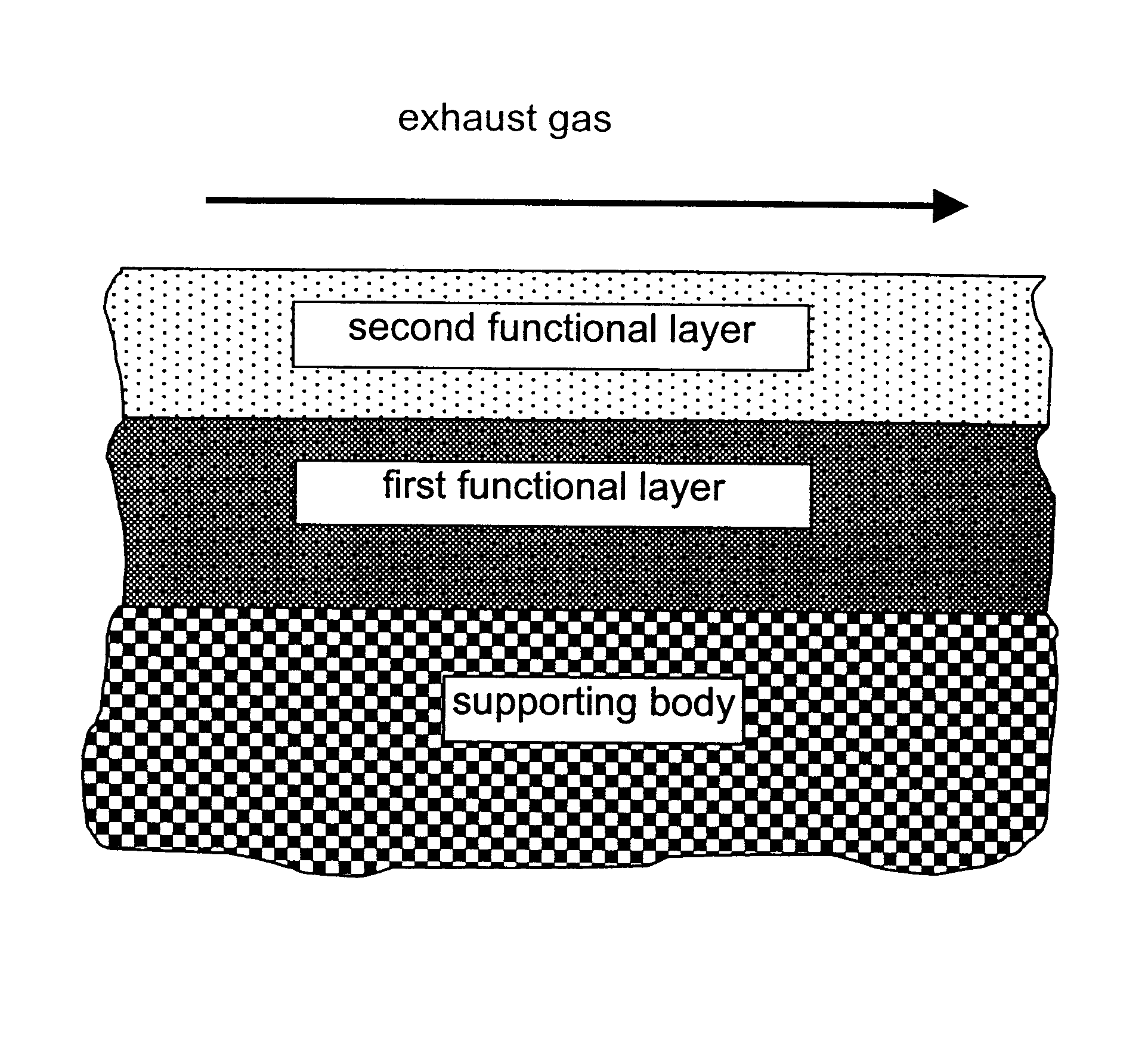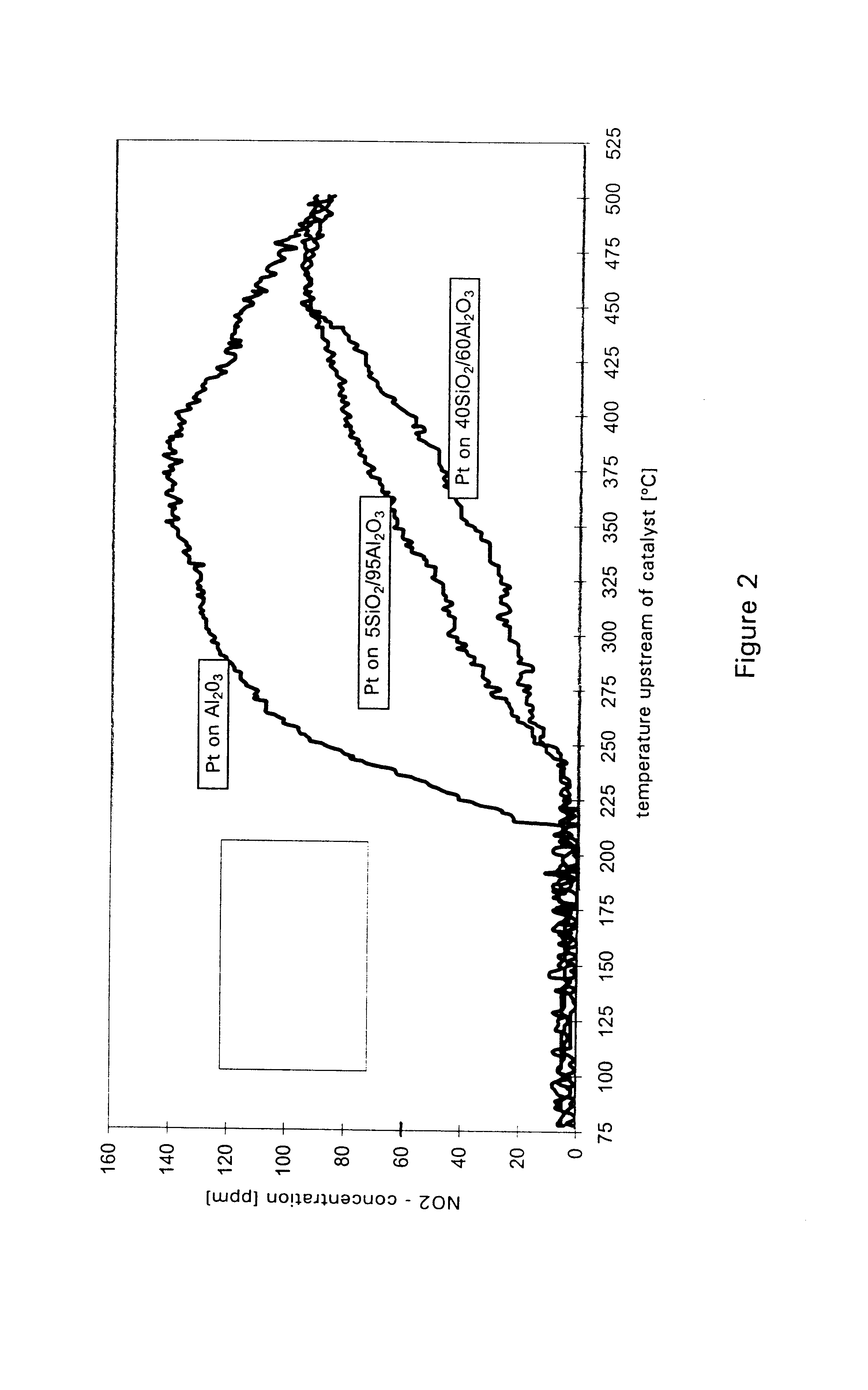Catalyst for cleaning up the exhaust gases of a diesel engine
a technology for cleaning up the exhaust gases of diesel engines and catalysts, which is applied in the direction of catalyst activation/preparation, metal/metal-oxide/metal-hydroxide catalysts, molecular sieve catalysts, etc., can solve the problems of reducing the specific surface area of the catalyst, and affecting the efficiency of the catalyst. , to achieve the effect of reducing the activity and high specific surface area
- Summary
- Abstract
- Description
- Claims
- Application Information
AI Technical Summary
Benefits of technology
Problems solved by technology
Method used
Image
Examples
example 1
A catalyst according to the invention with two functional layers was produced.
By way of first functional layer, the storage catalyst of Comparative Example 2 was applied. The oxide content was diminished proportionally by a factor of 0.78 in comparison with Comparative Example 2. The coating was dried in air at 120.degree. C. and finally calcined for 2 h at 500.degree. C.
By way of second functional layer, the reduction catalyst of Comparative Example 1 was applied. The oxide content was diminished in comparison with Comparative Example 1 by a factor of 0.71. The platinum loading of the second functional layer amounted to 3.18 g / l. The coating was dried in air at 120.degree. C., calcined for four hours at 300.degree. C. and finally reduced for two hours at 500.degree. C. under forming gas.
example 2
Another catalyst according to the invention was produced.
By way of first functional layer, use was made of the storage catalyst of Comparative Example 2. The oxide content was diminished proportionally by a factor of 0.78 in comparison with Comparative Example 2. The coating was dried in air at 120.degree. C. and finally calcined for two hours at 500.degree. C.
The second functional layer was produced as follows:
A solids mixture consisting of 85 wt.-% aluminum silicate (5 wt.-% silicon dioxide; specific surface area: 147 m.sup.2 / g) and 15 wt.-% de-aluminized zeolite Y (x=200) was activated with platinum. To this end, the solids mixture was brought into contact with an aqueous solution of ethanolamineplatinum(IV) hydroxide, subject to continual stirring, so that a moist, free-flowing powder was formed. After drying in air for twelve hours at 120.degree. C., the powder which had formed was calcined in air for four hours at 300.degree. C. and reduced at 500.degree. C. for a period of t...
example 3
Another catalyst according to the invention was prepared. The first functional layer was produced in the following way:
A zirconium dioxide powder (specific surface area: 103 m.sup.2 / g) was impregnated with 10.64 wt.-% CeO.sub.2, 9.50 wt.-% La.sub.2 O.sub.3 and 3.8 wt.-% Pd. To this end, an aqueous solution consisting of cerium(III) nitrate, lanthanum(III) nitrate and palladium(II) nitrate was applied with the appropriate weight ratios onto the zirconium dioxide powder, subject to continual agitation, so that a moist, impregnated zirconium dioxide powder was formed. After drying in air for two hours at 150.degree. C., the powder which had formed was calcined in air for two hours at 600.degree. C.
An aqueous coating dispersion with a solids content of 40 wt.-% was produced by using the impregnated zirconium oxide powder as well as aluminum oxide (specific surface area: 134 m.sup.2 / g) and cerium / zirconium mixed oxide (70 / 30; surface area: 104 m.sup.2 / g). The proportion of the zirconi...
PUM
| Property | Measurement | Unit |
|---|---|---|
| molar ratio | aaaaa | aaaaa |
| concentration | aaaaa | aaaaa |
| specific surface area | aaaaa | aaaaa |
Abstract
Description
Claims
Application Information
 Login to View More
Login to View More - R&D
- Intellectual Property
- Life Sciences
- Materials
- Tech Scout
- Unparalleled Data Quality
- Higher Quality Content
- 60% Fewer Hallucinations
Browse by: Latest US Patents, China's latest patents, Technical Efficacy Thesaurus, Application Domain, Technology Topic, Popular Technical Reports.
© 2025 PatSnap. All rights reserved.Legal|Privacy policy|Modern Slavery Act Transparency Statement|Sitemap|About US| Contact US: help@patsnap.com



